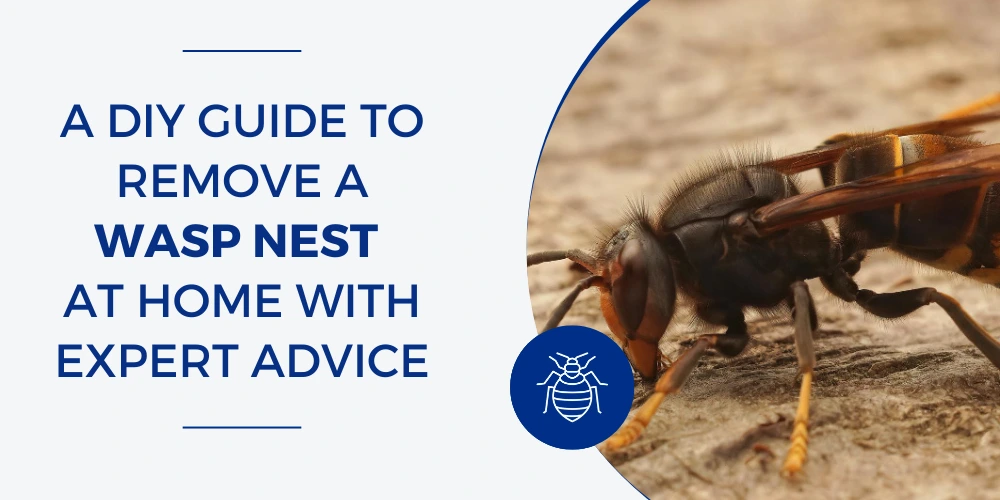Have you discovered a wasp nest on your property? Removing it is not a trivial task, as it needs expert advice to tackle.
Timing, safety precautions, and appropriate technique can significantly impact the outcome, separating a simple solution from an unpleasant encounter. For properly controlling wasp nests, Arizona people have long depended on tested techniques.
This article presents an opportunity for us to assist you in safely and effectively addressing your pest issues. Let's review the knowledge you need to rapidly, successfully, and securely grab control of that nest.
Wasps Are More Aggressive Than You Think
There are a lot of very dangerous creatures protecting that papery structure, even though they look small.
Unlike honeybees, wasps may strike often without dying; hence, one single wasp can cause many severe stings.
When their nest is threatened, wasps strike in synchronized swarms.
Hundreds or maybe thousands of wasps, all suited for aggressive defense, can fit within a mature wasp nest.
Particularly in late summer and autumn, when colonies peak, Arizona's yellow jackets, paper wasps, and hornets are very territorial.
Disturbed wasps produce pheromones alerting others to join the assault. What starts as an encounter with one wasp may rapidly turn into confronting hundreds of enraged, stinging insects in a few seconds.
DIY Nest Removal Often Goes Wrong
The internet is filled with home remedies and DIY approaches for wasp nest removal, but most of these methods are ineffective and dangerous:
- Spraying nests with water may temporarily knock down a nest, but typically enrages the wasps without killing them
- Using fire (such as torches or burning the nest) creates obvious fire hazards and doesn't guarantee elimination
- Store-bought sprays often have insufficient range, forcing you to get dangerously close to the nest
- Hitting or knocking down nests with brooms or poles virtually guarantees an aggressive counterattack
Many homeowners underestimate how quickly wasps respond to threats. By the time you realize your DIY pest control approach isn't working, you're often already surrounded by agitated wasps with no easy escape route.
Bug & Weed Mart is always available to listen to your queries and offer proper advice to resolve them as quickly as possible.
You Risk Serious Injury or Allergic Reactions
The health risks associated with wasp stings extend far beyond temporary pain:
- Multiple stings can cause severe swelling, intense pain, dizziness, nausea, and difficulty breathing, even in non-allergic individuals
- For approximately 5% to 7% of the population with insect sting allergies, even a single sting can trigger potentially fatal anaphylactic shock.
- Children and elderly individuals typically experience more severe reactions to wasp venom.
- Pets can suffer serious injuries or death from multiple stings, particularly when stung around the face or throat.
Even if you've never experienced an allergic reaction before, sensitivity to wasp venom can develop at any time. Without immediate access to medical care, what starts as a money-saving DIY project could end in the emergency room.
Wasp Nests Are Often in Hard-to-Reach or Dangerous Areas
Working Safely Around Challenging Nest Locations
Wasp nests often end up in tricky spots, but with the right approach, you can handle them safely:
Elevated nests under eaves or overhangs: Use a sturdy ladder with someone spotting you. Plan your escape route before you start - know exactly how you'll get down quickly if needed. Treat these nests at dawn or dusk when wasps are less active.
Nests in wall voids or enclosed spaces: These require patience and the right technique. Locate all entry points first, then treat the main entrance at night when wasps have returned to the nest. Seal alternate exits only after treatment to avoid trapping angry wasps inside your walls.
Ground nests from yellow jackets: Mark the nest location during daylight, then return after dark. Pour treatment directly into the entrance hole and cover immediately with a shovel full of dirt. The key is working when they're all inside and less aggressive.
Tree-dwelling colonies: Use a long-reach sprayer to maintain a safe distance. Never position yourself directly under the nest - wasps will drop down when disturbed. Work from the side and have your escape path clear.
The secret to handling difficult locations is preparation and timing. Scout the area during daylight, plan your approach, gather your tools, then execute the removal when wasps are least active.
Making Sure Your DIY Removal Works
Eliminating a wasp nest personally marks just the first step. This helps to ensure that the issue never resurfaces:
Don't allow the queen to flee. Time your removal for early morning or evening when the colony is entirely in the nest. If you address it during the day while workers are out foraging, the queen and returning wasps might easily start again somewhere else on your property.
It is essential to follow up. Look around a few days following removal. Sometimes, a few stragglers will attempt to rebuild in the same location. If you see activity returning, hit them with yet another therapy.
Bug & Weed Mart wants to assist you in preventing wasps from returning, not just help you eliminate the nest.
Start by getting rid of what originally drew them. Look around for food supplies, including pet food, spilled sweets, dropped fruit, or open garbage. Eliminate these attractants. Otherwise, you could be encouraging the next colony to move in.
Seal up possible nesting sites next. Repair loose siding, seal up cracks close to eaves and rooflines, and close wall cavities. Removing access to protected locations where wasps establish nests helps prevent recurring problems.
Use residual treatment to project forward. Eliminate the nest, then cover the retirees with residual pesticide spray. The residual spray forms a long-lasting barrier that keeps fresh colonies from developing at the same location under control.
Remember that Arizona's warm temperature lets wasps remain active for more time than in colder areas. In one season, you may run over many generations. Thus, maintaining your yard and house free from wasps depends on careful removal and aggressive preventive measures.
Conclusion
For little wasp nests near your house, do-it-yourself home pest control items may be a clever and efficient fix when applied with the correct safety measures. Without the expense of expert advice, they provide a sensible approach to managing small infestations.
For bigger or more difficult to reach nests, however, the hazards may soon exceed the benefits. Without appropriate training and tools, aggressive wasps, secret nest sites, and the possibility of allergic responses make these circumstances hazardous. Under these circumstances, we highly advise calling a registered pest treatment specialist.
At Bug & Weed Mart, we offer professional advice and the right products to help you remove wasp nests safely. Remember, DIY doesn’t mean you’re doing it alone. When you shop with us, you get expert advice, product recommendations, and practical tips that actually work.
And if you’ve already been stung while dealing with a nest, don’t panic. Check out our helpful guide on " 5 Natural Wasp Sting Treatments " to relieve pain and reduce swelling using remedies you can find at home.

